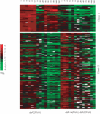Identification of direct target genes using joint sequence and expression likelihood with application to DAF-16
- PMID: 18350157
- PMCID: PMC2266795
- DOI: 10.1371/journal.pone.0001821
Identification of direct target genes using joint sequence and expression likelihood with application to DAF-16
Abstract
A major challenge in the post-genome era is to reconstruct regulatory networks from the biological knowledge accumulated up to date. The development of tools for identifying direct target genes of transcription factors (TFs) is critical to this endeavor. Given a set of microarray experiments, a probabilistic model called TRANSMODIS has been developed which can infer the direct targets of a TF by integrating sequence motif, gene expression and ChIP-chip data. The performance of TRANSMODIS was first validated on a set of transcription factor perturbation experiments (TFPEs) involving Pho4p, a well studied TF in Saccharomyces cerevisiae. TRANSMODIS removed elements of arbitrariness in manual target gene selection process and produced results that concur with one's intuition. TRANSMODIS was further validated on a genome-wide scale by comparing it with two other methods in Saccharomyces cerevisiae. The usefulness of TRANSMODIS was then demonstrated by applying it to the identification of direct targets of DAF-16, a critical TF regulating ageing in Caenorhabditis elegans. We found that 189 genes were tightly regulated by DAF-16. In addition, DAF-16 has differential preference for motifs when acting as an activator or repressor, which awaits experimental verification. TRANSMODIS is computationally efficient and robust, making it a useful probabilistic framework for finding immediate targets.
Conflict of interest statement
Figures



References
-
- Iyer VR, Horak CE, Scafe CS, Botstein D, Snyder M, et al. Genomic binding sites of the yeast cell-cycle transcription factors SBF and MBF. Nature. 2001;409:533–538. - PubMed
-
- Ren B, Robert F, Wyrick JJ, Aparicio O, Jennings EG, et al. Genome-wide location and function of DNA binding proteins. Science. 2000;290:2306–2309. - PubMed
-
- Bailey TL, Elkan C. Fitting a mixture model by expectation maximization to discover motifs in biopolymers. Proc Int Conf Intell Syst Mol Biol. 1994;2:28–36. - PubMed
-
- Liu XS, Brutlag DL, Liu JS. An algorithm for finding protein-DNA binding sites with applications to chromatin-immunoprecipitation microarray experiments. Nat Biotechnol. 2002;20:835–839. - PubMed
Publication types
MeSH terms
Substances
LinkOut - more resources
Full Text Sources
Molecular Biology Databases
Miscellaneous

